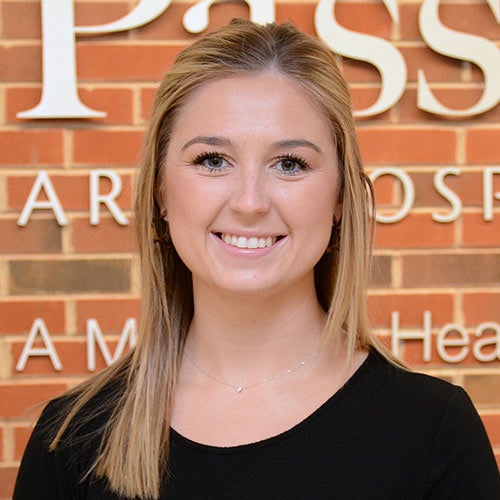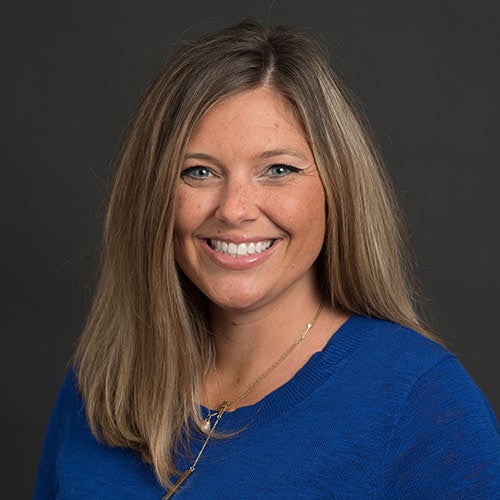Spotlight Feature

Haley Urish, RN
Patient care coordinator
Passavant Area Hospital, Jacksonville, Ill.

Sarah Karraker, LCSW
Manager of quality safety & safety operations improvement
Passavant Area Hospital, Jacksonville, Ill.
Background: About 200 miles south of Chicago is the community of Jacksonville, home to Passavant Area Hospital. This medical center, serving rural areas of central Illinois, is one of 13 state hospitals and health centers awarded a program grant aimed at reducing disparities in health care. Through a collaboration between the American Hospital Association’s Institute for Diversity and Health Equity (IFDHE) and Blue Cross Blue Shield of Illinois (BCBSIL), Passavant received funding support to initiate its new Healthy Jacksonville Program, aimed at pediatric asthma treatment and prevention throughout its community. In Morgan County, where Passavant is located, the pediatric asthma rate for African American children is five times higher than the overall population. Along with the implementation of the Healthy Jacksonville program, Passavant is conducting implementation of a focused intervention addressing this previously identified health disparity. It will also report baseline data as well as collect racial, ethnic and language preference (REaL) data to further advance health equity.
In this Spotlight Feature interview, Haley Urish, RN and patient care coordinator at Passavant along with Sarah Karraker, LCSW and Passavant’s manager of quality safety & operations improvement, discuss program goals for helping the youngest patients in the hospital’s surrounding community.
Why did your hospital decide to move forward with this new initiative?
In 2017, Passavant Area Hospital identified socioeconomic gaps in our community through a Community Health Needs Assessment and through results reported by the Robert Wood Johnson Foundation. Our mission at Passavant is to ensure quality health care is available to the community we serve and we knew that more had to be done.
“We will often see that once social barriers are corrected, physical health will also improve.”
Our Healthy Jacksonville Program was established in 2018. As we began designing this program, we realized there were great social and medical programs in our community; however, some people did not know how to access services. Healthy Jacksonville aimed to link community members to social and medical agencies that could improve their quality of life.
We really zeroed-in on social determinants of health in our community, which are conditions in which we live that affect our health outcomes. Unstable housing, safety, education, and nutrition are a few factors that can contribute to poor health care. Healthy Jacksonville focuses on lower socioeconomic portions of the community with a goal to bridge any gaps in social or medical care. We will often see that once social barriers are corrected, physical health will also improve.
While doing research, we found that asthma can be challenging to manage for families living in poverty. According to the Asthma and Allergy Foundation of America, many cities reporting high rates of pediatric asthma also list poverty as a top risk factor.
We regularly review our emergency department data and found that there is a disproportionate amount of African American children being brought in to the department for asthma-related illness. After doing research and applying our understanding of the social determinants of health, we knew this was likely related to socioeconomic conditions of the population. Our new pediatric asthma treatment and prevention initiative will allow us to have resources dedicated to closing some of our health care gaps identified in our community.
What is the goal of your program, and how do you anticipate this program impacting your patient population?
“By having an understanding of socioeconomic conditions, we are able to approach situations appropriately to ensure we are making the most effective and patient-centered impact as possible.”
The overall program goal is to link people in the community who suffer from social determinants of health to programs that can help them become more sustainable. We work to motivate community members to be active in their care plans and advocate for themselves.
For this program, our information services department created a report to identify children discharged from our Emergency Department with a diagnosis of asthma. Community health workers are able to view this report and contact parents of those children – first with a phone call to arrange an in person introduction and home visit.
The community health worker then spends time with the child and their family at home, making assessments of ways to improve air quality and reduce the triggers of asthma. That process includes an asthma assessment tool we created that is used at each home visit to assess the child’s management of asthma. We’ve found this visual aid tool helps parents track how their child feels each day. We also provide each family with asthma friendly kits to improve their air quality and environmental dust factors.
There is also a 3-step follow-up effort to evaluate, educate and provide interventions to improve a child’s chances of avoiding reoccurrences of asthma. The community health worker also schedules future follow-up home visits with the family.
Individualized needs of the program also address working with families to find primary care physicians, arranging specialists if indicated, obtaining medications, providing education and resources, attending appointments with families if appropriate, and addressing any other social need that is preventing families from living a healthy lifestyle. Furthermore, in terms of overall health equity improvements, we complete comprehensive assessments that allow us to identify specific barriers that our patients may face. Part of the assessment includes identifying patients’ health care goals and areas that they find important for achieving greater health.
Unfortunately, we often find cycles of poverty that can be difficult to break. These challenging situations provide opportunities to identify needs or areas of improvement for our patients and community.
Does a clearer understanding of socioeconomic conditions impacting patients and other barriers to health equity help you build a better program? How?
Our Pediatric Asthma Program fits nicely within our existing community health program because we’re able to provide follow-up medical care in the community. We’re able to remove transportation and other social barriers that may be preventing access to care or a family’s ability to obtain medications. This enables a pediatric asthma patient to live in a healthy environment with quality healthcare that otherwise may not be obtained.
A clear understanding of socioeconomic conditions must be understood to deeply impact social determinants of health. If a family is not able to pay rent or at risk of losing electricity, along with no food in their home and no access to transportation, they will probably not be able to get their child’s medications or take their children to follow-up doctor appointments to manage their asthma.
Referrals, connections, point of contacts can be made to agencies to help bridge social gaps impacting health care. Once these types of issues are handled, parents may have increased confidence with their child’s medical management. With this increase in confidence, parents may find an intensified importance of their child’s health care, medications, and/or doctor appointments.
By having an understanding of socioeconomic conditions, we are able to approach situations appropriately to ensure we are making the most effective and patient-centered impact as possible. Also, by understanding root causes of a family’s dynamics and social barriers, it’s easy to see why having a program such as Healthy Jacksonville is valuable.
What information would you share with other member hospitals about advancing health care equity within their organization?
Evaluating your local community to identify social and economic needs is very important. Health care won’t change for many individuals if their socioeconomic status and barriers go undetected. In order for a community to have health care equality, they must be able to access high-quality care by reducing barriers related to their social determinants of health.
